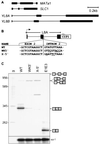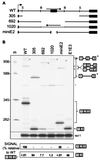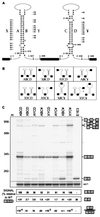Intron self-complementarity enforces exon inclusion in a yeast pre-mRNA
- PMID: 9356473
- PMCID: PMC25003
- DOI: 10.1073/pnas.94.23.12467
Intron self-complementarity enforces exon inclusion in a yeast pre-mRNA
Abstract
Skipping of internal exons during removal of introns from pre-mRNA must be avoided for proper expression of most eukaryotic genes. Despite significant understanding of the mechanics of intron removal, mechanisms that ensure inclusion of internal exons in multi-intron pre-mRNAs remain mysterious. Using a natural two-intron yeast gene, we have identified distinct RNA-RNA complementarities within each intron that prevent exon skipping and ensure inclusion of internal exons. We show that these complementarities are positioned to act as intron identity elements, bringing together only the appropriate 5' splice sites and branchpoints. Destroying either intron self-complementarity allows exon skipping to occur, and restoring the complementarity using compensatory mutations rescues exon inclusion, indicating that the elements act through formation of RNA secondary structure. Introducing new pairing potential between regions near the 5' splice site of intron 1 and the branchpoint of intron 2 dramatically enhances exon skipping. Similar elements identified in single intron yeast genes contribute to splicing efficiency. Our results illustrate how intron secondary structure serves to coordinate splice site pairing and enforce exon inclusion. We suggest that similar elements in vertebrate genes could assist in the splicing of very large introns and in the evolution of alternative splicing.
Figures




Similar articles
-
Requirements for mini-exon inclusion in potato invertase mRNAs provides evidence for exon-scanning interactions in plants.RNA. 2000 Mar;6(3):422-33. doi: 10.1017/s1355838200992173. RNA. 2000. PMID: 10744026 Free PMC article.
-
Correlation between the secondary structure of pre-mRNA introns and the efficiency of splicing in Saccharomyces cerevisiae.BMC Genomics. 2008 Jul 29;9:355. doi: 10.1186/1471-2164-9-355. BMC Genomics. 2008. PMID: 18664289 Free PMC article.
-
The architecture of pre-mRNAs affects mechanisms of splice-site pairing.Proc Natl Acad Sci U S A. 2005 Nov 8;102(45):16176-81. doi: 10.1073/pnas.0508489102. Epub 2005 Oct 31. Proc Natl Acad Sci U S A. 2005. PMID: 16260721 Free PMC article.
-
Unannotated splicing regulatory elements in deep intron space.Wiley Interdiscip Rev RNA. 2021 Sep;12(5):e1656. doi: 10.1002/wrna.1656. Epub 2021 Apr 22. Wiley Interdiscip Rev RNA. 2021. PMID: 33887804 Review.
-
The effects of structure on pre-mRNA processing and stability.Methods. 2017 Aug 1;125:36-44. doi: 10.1016/j.ymeth.2017.06.001. Epub 2017 Jun 6. Methods. 2017. PMID: 28595983 Free PMC article. Review.
Cited by
-
Intronic RNA: Ad'junk' mediator of post-transcriptional gene regulation.Biochim Biophys Acta Gene Regul Mech. 2019 Nov-Dec;1862(11-12):194439. doi: 10.1016/j.bbagrm.2019.194439. Epub 2019 Nov 1. Biochim Biophys Acta Gene Regul Mech. 2019. PMID: 31682938 Free PMC article. Review.
-
Secondary structure is required for 3' splice site recognition in yeast.Nucleic Acids Res. 2011 Dec;39(22):9759-67. doi: 10.1093/nar/gkr662. Epub 2011 Sep 5. Nucleic Acids Res. 2011. PMID: 21893588 Free PMC article.
-
Rates of spontaneous mutation.Genetics. 1998 Apr;148(4):1667-86. doi: 10.1093/genetics/148.4.1667. Genetics. 1998. PMID: 9560386 Free PMC article. Review.
-
The position of yeast snoRNA-coding regions within host introns is essential for their biosynthesis and for efficient splicing of the host pre-mRNA.RNA. 2007 Jan;13(1):138-50. doi: 10.1261/rna.251907. Epub 2006 Nov 29. RNA. 2007. PMID: 17135484 Free PMC article.
-
Perturbation of transcription elongation influences the fidelity of internal exon inclusion in Saccharomyces cerevisiae.RNA. 2003 Aug;9(8):993-1006. doi: 10.1261/rna.5390803. RNA. 2003. PMID: 12869710 Free PMC article.
References
-
- Green M. Annu Rev Cell Biol. 1991;7:559–599. - PubMed
-
- Moore M J, Query C C, Sharp P A. In: The RNA World. Gesteland R F, Atkins J F, editors. Plainview, NY: Cold Spring Harbor Lab. Press; 1993. pp. 303–357.
-
- Ruby S R, Abelson J. Science. 1988;242:1028–1035. - PubMed
-
- Michaud S, Reed R. Genes Dev. 1993;7:1088–1020. - PubMed
Publication types
MeSH terms
Substances
Grants and funding
LinkOut - more resources
Full Text Sources
Other Literature Sources
Molecular Biology Databases

